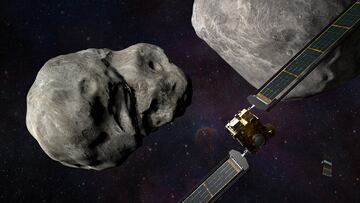How much has the DART robotic suicide mission cost?
The probe is purpose built to protect Earth from dangerous space debris but has yet to be trialled. Tonight is the first major test.

At approximately 21.14 ET, NASA will intentionally crash the DART probe into Dimorphos. This is a test to see if man-made objects would be successful in preventing asteroids from destroying life on Earth.
What is Dimorphos you say? Well, it is a moon of the asteroid Didymos. As that means precisely nothing to anyone but a NASA scientist let us put it in a bit of perspective.
Dimorphos is 163 metres wide, making it nearly twice the height of the Eiffel Tower. In comparison DART (Double Asteroid Redirection Test) is only 19 metres in width and weighs 570kg, the size of a small car, especially by American standards. Clearly the probe is the David to Dimorphos’ Goliath.
“Dart is the first planetary defence test mission to demonstrate running a spacecraft into an asteroid to move the position of that asteroid ever so slightly in space,” explained Dr Nancy Chabot from the Johns Hopkins University Applied Physics Laboratory, which leads the mission for NASA.
Whether it will work or not is pretty much the point of the test.
How much will the DART programme cost?
According to The Planetary Society, a foundation supported by scientists like Bill Nye and Neil deGrasse Tyson, the programme will cost in total $324.5 million.
How was this funded?
NASA has a budget allocated by the federal government with each budget. For the financial year of 2022 $30.61 billion was allocated to the agency according to data from the USAspending.gov site. This represents 0.2 percent of the US federal budget.
Listed in the funding as a seperate entity is the money for the launch services. This $68.8 million is under a subheading of Falcon 9, one of the rocket projects provided by SpaceX. it is an orbital rocket that is capable of landing and has the ability to be reused. This is not counted as contributing to the cost of the programme due to NASA’s contract with SpaceX.
Since 2011 NASA has been utilising their Commercial Crew programme. This is a plan by NASA to involve the private sector more in its space missions with companies like SpaceX and Boeing. The reason for joining with the private sector is that NASA wants to focus more on deep space missions, and to achieve its target of landing the first woman and person of colour on the moon.






